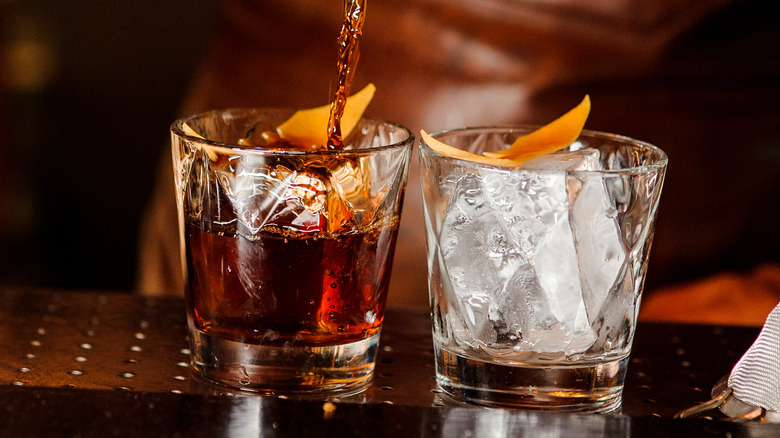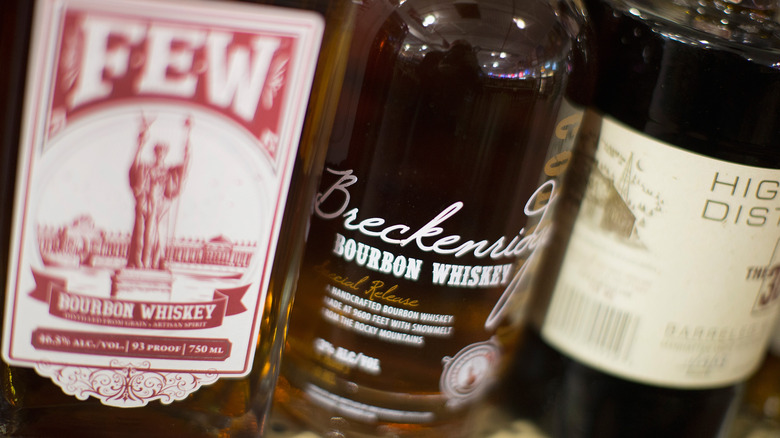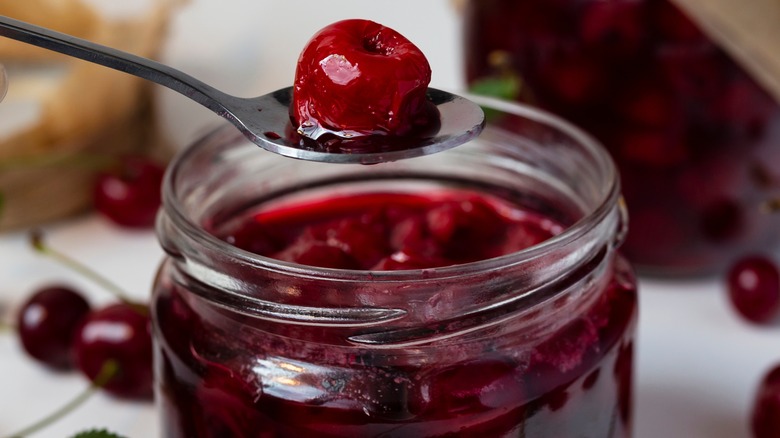The Unexpected Ingredient That Will Take Your Old Fashioned Up A Notch
As one of the six classic cocktails, the Old Fashioned has a reserved spot on the menus of bars worldwide. Tommy Flynn, beverage director of New York's Paper Daisy, explained to Eater that the cocktail is elegant and simple, yet meticulous to master — the kind of drink meant to put whiskey on a pedestal by using just the right amount of sweetness and aromatics to complement the nuances of the spirit.
If we go back to the origins of the cocktail, or at least one of the first written recipes in Modern American Drinks by George Kappeler (originally published in 1895), we find the most basic rendition of the drink: "Dissolve a small lump of sugar with a little water in a whiskey-glass; add two dashes of Angostura bitters, a small piece ice, a piece lemon peel, one jigger whiskey. Mix with small bar-spoon and serve." With this recipe, the Old Fashioned has stood as a template for nearly every kind of classic cocktail since: Start with a base spirit, then add a sweetening agent, a bittering agent, and garnish.
However, in an effort to build upon this time-honored classic, mixologists and bartenders are constantly finding inventive ways of breaking away from tradition, and they have discovered that the addition of one more ingredient is a modern must for any elevated Old Fashioned recipe. But, as each ingredient in an Old Fashioned exists to play a particular role in elevating the whiskey, it's important to consider the ingredient dynamics and how the new addition fits the scene.
The devil's in the details
Nowadays, a frequent Old Fashioned whiskey of choice is bourbon because of its flavor profile, which typically includes notes of walnut, toasted oak, vanilla, cloves, and cocoa to name a few (according to Whiskey Muse). However, rye whiskey is no stranger to the Old Fashioned, either, due to its bold notes of earth, spice, and a little sweetness. Once you have an idea of the flavor profile of the base spirit, then comes finding the balance between sweet, bitter, floral, and fruity.
According to Cocktail Contessa, we add bitters to enhance the aromatics, giving depth to the cocktail while complimenting the more nuanced flavors of the whiskey. Meanwhile, Kindred Cocktails tells us that a sweetener in an Old Fashioned is there to act as a "binding agent" for all the flavors. Without it, the variety of tastes present in the whiskey is at odds with the bitters, creating dissonance in the drink. But a sweetener combats the acidity of both the spirit and bitters while adding body to the cocktail and, some may say, soothing some of the burn from the alcohol.
Finally, citrus peel garnish, whether it be lemon or the more contemporary orange, adds the illusion of acidity and floral fruitiness without over-sweetening the spirit, says VinePair of the consensus among cocktail experts. Almost any bartender will advise twisting the peel to "express" the oils, enhancing the overall aroma as you bring the glass to your face. And although any of these elements can be modified to elevate your Old Fashioned, the simple addition of a premium preserved cherry can take this cocktail to new heights.
The cherry on top
Instead of appealing to the olfactory senses with citrus and aromatic bitters, add a cherry to enhance the overall flavor of the cocktail. If you're using a bourbon with strong oak and vanilla notes, adding the right kind of cherry brings forth elements of cherry wood and stone fruit ... But how do you know which cherry is right? According to the experts at Saveur, one of the most important things to consider about cocktail cherries is their steeping liquid. Premium cocktail cherries will be steeped in spirits, liqueurs, or syrups, like Luxardo maraschino cherries (distinctly different from the overprocessed, neon-red sundae maraschinos), which are steeped in the Luxardo cherry juice that also serves as the base for their cherry liqueur.
Even further specialty options include Jack Rudy bourbon-soaked cocktail cherries (which naturally use bourbon in their steeping process) or Copper and Kings Old Fashioned cherries, which use their own brand of American brandy. If none of these quite capture the flavor profile to perfectly compliment your Old Fashioned, you could always attempt to make your own preserved cherries with a little juice, water, and sweet spirit. Finding the ideal cherry for the perfect Old Fashioned may be a meticulous process of trial and error, but that's all part of the worthwhile joy of cocktail crafting — an updated approach nonetheless befitting a classic.


